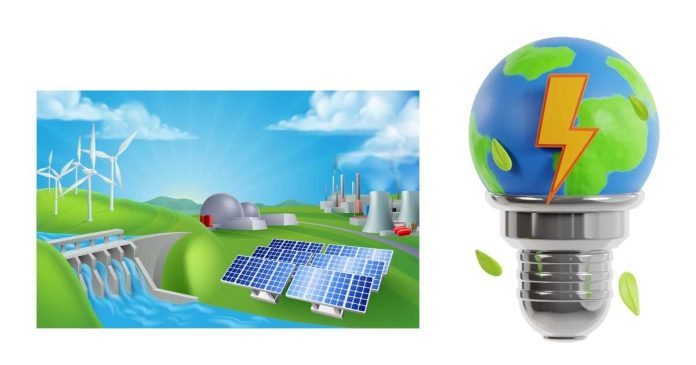The two main sources of energy in the Earth’s spheres (specifically the atmosphere, hydrosphere, lithosphere, and biosphere) are solar energy and geothermal energy. These sources are the fundamental drivers of many of Earth’s processes and systems. Let’s explore both of these sources in detail:
1. Solar Energy (Energy from the Sun):
- Description: Solar energy is the primary source of energy for life and processes on Earth. The Sun emits energy in the form of electromagnetic radiation, primarily visible light and infrared radiation, which travels through space and reaches Earth.
- Impact on Earth’s Systems:
- Atmosphere: The energy from the Sun heats the Earth’s atmosphere, influencing weather patterns and climate. Solar radiation is absorbed by the Earth’s surface and atmosphere, which then radiates this heat, driving the atmospheric circulation (winds, ocean currents, and weather systems).
- Hydrosphere: Solar energy is crucial for the water cycle. It heats bodies of water (oceans, lakes, rivers), causing evaporation, which leads to precipitation and influences the distribution of water across the planet.
- Lithosphere: Solar energy affects the Earth’s surface, contributing to the temperature variations that drive physical weathering and erosion of rocks. It also powers processes like photosynthesis in plants, which impacts the formation of organic matter and soil quality.
- Biosphere: Solar energy is the ultimate source of energy for all living organisms on Earth. Through photosynthesis, plants convert solar energy into chemical energy, which forms the foundation of the food chain. This energy supports ecosystems and sustains life on Earth.
- Renewability: Solar energy is renewable, meaning it is inexhaustible over human time scales. The Sun has been radiating energy for billions of years and is expected to continue doing so for billions more.
2. Geothermal Energy (Energy from Earth’s Interior):
- Description: Geothermal energy originates from the Earth’s internal heat, primarily from two sources: the radioactive decay of elements (such as uranium, thorium, and potassium) in the Earth’s crust and the residual heat from the planet’s formation. This heat is stored in the Earth’s core and radiates outward, affecting the lithosphere and even reaching the atmosphere in some cases.
- Impact on Earth’s Systems:
- Lithosphere: Geothermal energy plays a significant role in processes like volcanism, mountain building, and plate tectonics. The movement of tectonic plates, the formation of mountains, and the eruption of volcanoes are all driven by the heat emanating from the Earth’s interior. Geothermal energy is responsible for the Earth’s internal dynamics and the recycling of the crust.
- Hydrosphere: Geothermal energy also impacts water sources, such as hot springs and geysers. In certain regions, geothermal heat heats underground water, creating thermal features. This energy is also harnessed in geothermal power plants for electricity generation.
- Atmosphere: Although geothermal energy’s direct impact on the atmosphere is limited, in areas with significant volcanic activity, it can influence the composition of the atmosphere (e.g., through the release of gases like carbon dioxide and sulfur dioxide).
- Biosphere: While geothermal energy is not as directly connected to the biosphere as solar energy, it supports life in geothermal ecosystems, such as in hydrothermal vents at the bottom of the ocean. These ecosystems rely on chemical energy from geothermal processes rather than sunlight for sustenance.
- Renewability: Geothermal energy is generally considered renewable over long periods, though its availability can vary based on location. Unlike fossil fuels, it doesn’t emit carbon dioxide when harnessed, making it an environmentally friendly energy source.
Summary:
- Solar energy is the most significant source of energy for most of Earth’s systems. It powers the climate, drives the water cycle, and supports life through photosynthesis.
- Geothermal energy, sourced from the Earth’s interior, is responsible for internal processes like volcanism, plate tectonics, and some natural heat sources on Earth, and it also provides a sustainable energy source in some regions.
Together, these two sources—solar energy from the Sun and geothermal energy from the Earth’s core—are the primary drivers of natural processes across the Earth’s spheres.


